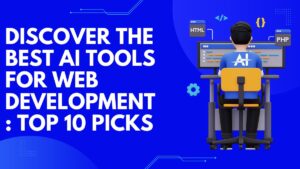Introduction
In today’s rapidly evolving digital landscape, artificial intelligence (AI) has become a game-changer in various industries. Web development, in particular, has benefited tremendously from the advancements in AI technology. With the power of AI tools, developers can streamline their workflows, enhance user experiences, and create innovative web solutions.
In this comprehensive guide, we will unveil the top 10 AI tools for web development that will empower you to stay ahead of the curve and achieve remarkable results.
1. TensorFlow
TensorFlow, developed by Google, is a popular open-source AI library that has revolutionized machine learning. TensorFlow has gained popularity in the machine learning community for its extensive documentation, active community support, and frequent updates, ensuring developers have access to the latest advancements and best practices.
Its top features include:
- Flexibility: TensorFlow offers a flexible architecture that allows developers to build and deploy machine learning models across various platforms and devices.
- Scalability: With TensorFlow, developers can scale their models seamlessly to handle large datasets and complex computations.
- Comprehensive Ecosystem: TensorFlow provides a comprehensive ecosystem of tools, libraries, and resources, making it easier for developers to experiment, innovate, and solve complex problems in web development.
- Wide Range of Applications: From natural language processing (NLP) to image recognition and time series forecasting, TensorFlow supports a wide range of AI applications, making it suitable for diverse web development projects.
2. Dialogflow
Dialogflow, powered by Google Cloud, is an AI-driven chatbot development platform. Dialogflow simplifies the chatbot development process with its intuitive interface, pre-built templates, and extensive language support, enabling developers to create sophisticated conversational experiences without extensive coding.
Its top features include:
- Natural Language Understanding: Dialogflow enables developers to build chatbots that can understand and interpret user queries in natural language, providing more human-like conversational experiences.
- Multi-Platform Support: With Dialogflow, developers can create chatbots that seamlessly integrate with various messaging platforms, voice assistants, and even custom interfaces.
- Contextual Understanding: Dialogflow allows chatbots to maintain context and provide relevant responses based on previous interactions, enhancing the overall user experience.
- Rich Multimedia Support: Developers can incorporate rich media elements, such as images, cards, and buttons, into their chatbot interactions, making conversations more engaging and interactive.
3. IBM Watson
IBM Watson is a leading AI platform that offers a wide array of tools and services for web development. IBM Watson stands out for its enterprise-grade security, extensive industry-specific solutions, and integration with other IBM Cloud services, providing developers with a comprehensive AI platform for web development.
Its top features include:
- Natural Language Processing (NLP): Watson’s NLP capabilities enable developers to analyze and extract insights from unstructured text data, empowering them to build web applications with advanced language understanding.
- Visual Recognition: IBM Watson’s visual recognition feature allows developers to integrate image analysis capabilities into their web projects, enabling functionalities such as object detection, image classification, and facial recognition.
- Machine Learning: Watson provides robust machine learning tools and algorithms that simplify the process of training and deploying models, enabling developers to create AI-powered web applications with ease.
- Speech-to-Text and Text-to-Speech: With Watson’s speech-to-text and text-to-speech capabilities, developers can add voice-enabled interfaces to their web applications, enhancing accessibility and user engagement.
4. Amazon Rekognition
Amazon Rekognition is a powerful image and video analysis service provided by Amazon Web Services (AWS). Amazon Rekognition’s seamless integration with other AWS services, robust API, and scalability make it a go-to choice for developers looking to incorporate advanced image and video analysis capabilities into their web applications.
Its top features include:
- Object and Scene Detection: Amazon Rekognition can detect and identify objects and scenes within images and videos, enabling developers to build web applications with advanced visual analysis capabilities.
- Facial Analysis: With Amazon Rekognition, developers can analyze faces in images and videos, extracting attributes such as emotions, age range, and facial landmarks. This feature is beneficial for applications involving face recognition and sentiment analysis.
- Moderation: Amazon Rekognition can help developers moderate user-generated content by identifying potentially inappropriate or unsafe visuals, enhancing user safety and compliance.
- Image Search: With Amazon Rekognition, developers can implement powerful image search functionality, allowing users to search for similar images based on visual similarity or specific objects within images.
5. Google Cloud Vision API
The Google Cloud Vision API is a cutting-edge AI tool that enables developers to integrate image recognition capabilities into their web applications. Google Cloud Vision API’s high accuracy, robust image annotation capabilities, and support for various programming languages make it a top choice for developers looking to incorporate powerful image recognition features into their web applications.
Its top features include:
- Label Detection: The Vision API can identify objects and entities within images, providing developers with valuable insights for categorization and content analysis.
- Optical Character Recognition (OCR): With OCR capabilities, developers can extract text from images, enabling functionalities such as automatic document processing and image-based search.
- Face Detection: The Vision API can detect and analyze faces within images, providing attributes like emotions, landmarks, and demographics. This feature is useful for applications involving facial analysis and user verification.
- Image Attributes: Google Cloud Vision API can detect image attributes such as colors, dominant hues, and landmarks, enabling developers to enhance visual experiences and provide personalized content recommendations.
6. Microsoft Azure Cognitive Services
Microsoft Azure Cognitive Services is a comprehensive suite of AI tools that caters to various web development needs. Microsoft Azure Cognitive Services stands out for its seamless integration with other Microsoft Azure products, extensive language support, and enterprise-grade security, making it a reliable choice for developers seeking AI capabilities for their web development projects.
Its top features include:
- Speech Recognition and Synthesis: Azure Cognitive Services offers speech recognition and synthesis capabilities, allowing developers to integrate voice interfaces and voice commands into their web applications.
- Sentiment Analysis: With sentiment analysis, developers can analyze text data to determine the sentiment or emotional tone, enabling applications such as social media monitoring and customer feedback analysis.
- Language Translation: Azure Cognitive Services provides powerful language translation capabilities, enabling developers to create multilingual web applications and reach a global audience.
- Entity Recognition: This feature allows developers to extract entities and key phrases from text data, facilitating tasks such as information extraction and content analysis.
7. OpenAI GPT-3
OpenAI’s GPT-3 is a state-of-the-art language model that has gained significant attention in the web development community. OpenAI GPT-3 has made significant strides in natural language processing and generation, and its versatility has led to its adoption in various web development domains, ranging from content generation to conversational agents.
Its top features include:
- Natural Language Generation: GPT-3 can generate human-like text based on given prompts, enabling developers to automate content creation for web applications, chatbots, and virtual assistants.
- Language Understanding: GPT-3 excels in understanding and processing natural language, enabling developers to build chatbots and virtual assistants that can engage users in meaningful conversations.
- Text Completion and Summarization: With GPT-3, developers can leverage advanced text completion and summarization capabilities, enhancing productivity and efficiency in generating concise and coherent content.
- Creative Writing: GPT-3’s ability to generate creative and imaginative text opens up possibilities for innovative storytelling, interactive narratives, and personalized content experiences on the web.
8. AutoML
AutoML (Automated Machine Learning) is an AI tool that simplifies the process of building and deploying machine learning models for web development tasks. AutoML’s user-friendly interface, automated workflows, and ability to generate production-ready models make it a valuable asset for developers seeking to incorporate machine learning capabilities into their web applications.
Its top features include:
- Automated Model Training: AutoML automates the process of model training, including tasks such as feature engineering, hyperparameter tuning, and model selection, saving developers time and effort.
- Custom Model Development: AutoML allows developers to create custom machine learning models tailored to their specific web development requirements, even without extensive machine learning expertise.
- Integration and Deployment: AutoML seamlessly integrates with various development frameworks and platforms, enabling easy deployment of trained models into web applications.
- Transfer Learning: AutoML leverages transfer learning techniques, enabling developers to build high-performing models using smaller datasets and reducing the need for extensive labeled data.
9. Salesforce Einstein
Salesforce Einstein is an AI-powered CRM platform that offers a range of features for web development. Salesforce Einstein’s integration with the Salesforce CRM ecosystem, extensive AI capabilities, and user-friendly interface make it a powerful tool for web developers looking to leverage AI in their customer relationship management and web development processes.
Its top features include:
- Predictive Analytics: Einstein leverages AI and machine learning to provide predictive insights, enabling web developers to anticipate customer behavior, personalize user experiences, and optimize marketing campaigns.
- Recommendation Engine: Salesforce Einstein’s recommendation engine suggests personalized content, products, or actions based on user preferences and historical data, driving engagement and conversions on web applications.
- Lead Scoring: Einstein’s lead scoring capabilities help web developers prioritize and qualify leads based on their likelihood of conversion, improving sales team efficiency and effectiveness.
- Automated Data Analysis: Einstein automates data analysis tasks, enabling developers to uncover patterns, trends, and anomalies in web application data, facilitating data-driven decision-making.
10. Google PageSpeed Insights
While not directly an AI tool, Google PageSpeed Insights plays a crucial role in optimizing web performance, which is a significant ranking factor in search engine results. Google PageSpeed Insights empowers web developers to optimize their web applications for speed, user experience, and search engine visibility, ensuring their web projects deliver a smooth and engaging experience to users.
Its top features include:
- Website Performance Analysis: PageSpeed Insights analyzes web pages and provides detailed reports on various performance metrics, such as page load time, render-blocking resources, and overall user experience.
- Actionable Recommendations: The tool provides actionable recommendations to optimize web page performance, including suggestions for code minification, image compression, and browser caching.
- Mobile-Friendly Evaluation: PageSpeed Insights evaluates web pages for mobile-friendliness, ensuring optimal experiences for users accessing the web application from mobile devices.
- SEO Impact: Improving web performance using PageSpeed Insights can positively impact search engine rankings, leading to increased visibility and organic traffic for web applications.
Conclusion
In this guide, we have explored the top 10 AI tools for web development that can propel your projects to new heights. Each tool offers by custom AI development company include unique features and capabilities, empowering developers to streamline workflows, enhance user experiences, and unlock new possibilities.
Whether you’re building machine learning models with TensorFlow, creating conversational chatbots with Dialogflow, or optimizing web performance with Google PageSpeed Insights, incorporating these AI tools into your web development arsenal can help you outrank the competition and deliver exceptional results in today’s AI-driven landscape.







Leave a Reply